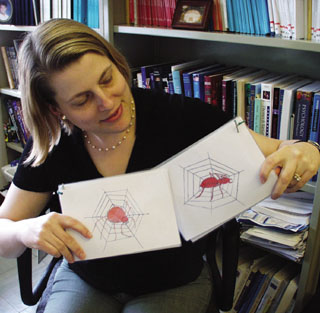|
|
.gif)
A
child is shown a prompt card with a spider’s web (the left
card held in the photo by Dr Catherine McBride-Chang of The Chinese
University of Hong Kong). The child is then shown another card with
an ant on a web (the right card) and asked what it is. A good answer,
showing morphological awareness, said Dr McBride-Chang, would be
“ant web.”
 |
| Dr McBride-Chang and prompt cards |
Morphological awareness,
the ability to combine familiar spoken units of meaning or morphemes
to create new meanings, can be used as an indicator of a child’s
reading development, especially in Chinese, says Dr McBride-Chang.
In English, however, the equivalent important skill is phonological
awareness, the ability to make words from different combinations of
phonemes, or speech sounds, typically represented as individual letters.
For example, if asked to say “split” without the /p/ sound,
a child should be able to answer “slit.”
 Phonological
awareness has been used by researchers as a “predictor”
of skill in using alphabet-based languages for years. But Dr McBride-Chang
believes morphological awareness can be just as successfully applied
to predict ability in Chinese. Phonological
awareness has been used by researchers as a “predictor”
of skill in using alphabet-based languages for years. But Dr McBride-Chang
believes morphological awareness can be just as successfully applied
to predict ability in Chinese.
 To
illustrate that improved morphological awareness comes with greater
skill in reading, she tested 100 kindergarten and 100 second grade
children in Hong Kong and found that, consistently across groups,
morphological awareness was the only unique predictor of Chinese character
recognition beyond the variance accounted for by phonological awareness,
vocabulary knowledge, and many other reading-related skills. To
illustrate that improved morphological awareness comes with greater
skill in reading, she tested 100 kindergarten and 100 second grade
children in Hong Kong and found that, consistently across groups,
morphological awareness was the only unique predictor of Chinese character
recognition beyond the variance accounted for by phonological awareness,
vocabulary knowledge, and many other reading-related skills.
 Another
study by Dr McBride-Chang found that morpho-logical awareness and
word recognition are strongly associated with second graders in Hong
Kong, Beijing and Korea, but not for their counterparts in the United
States. In contrast, phonological awareness is found important in
reading English as well as Korean which is alphasyllabic and has 50
percent of words borrowed from Chinese but not for the Chinese samples. Another
study by Dr McBride-Chang found that morpho-logical awareness and
word recognition are strongly associated with second graders in Hong
Kong, Beijing and Korea, but not for their counterparts in the United
States. In contrast, phonological awareness is found important in
reading English as well as Korean which is alphasyllabic and has 50
percent of words borrowed from Chinese but not for the Chinese samples.
 Dr
McBride-Chang believes that using morphological awareness as a predictor
can not only diagnose potential language problems such as dyslexia
and language delay but can also be used as an aid to language learning. Dr
McBride-Chang believes that using morphological awareness as a predictor
can not only diagnose potential language problems such as dyslexia
and language delay but can also be used as an aid to language learning.
Principal Investigator
Dr Catherine McBride-Chang : cmcbride@psy.cuhk.edu.hk

|

